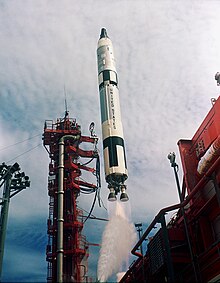Titan II GLV
 Launch of Gemini 11 on a Titan II GLV from LC-19 | |
| Function | Manned launch system |
|---|---|
| Manufacturer | Martin |
| Country of origin | |
| Size | |
| Height | 31.4 metres (103 ft) |
| Diameter | 3.05 metres (10.0 ft) |
| Mass | 154,000 kilograms (340,000 lb) |
| Stages | 2 |
| Capacity | |
| Payload to LEO | |
| Mass | 3,600 kilograms (7,900 lb) |
| Associated rockets | |
| Family | Titan |
| Launch history | |
| Status | Retired |
| Launch sites | Cape Canaveral LC-19 |
| Total launches | 12 |
| Success(es) | 12 |
| First flight | 8 April 1964 |
| Last flight | 11 November 1966 |
| Type of passengers/cargo | Gemini |
| First stage | |
| Powered by | 2 LR-87 |
| Maximum thrust | 1,900 kilonewtons (430,000 lbf) |
| Specific impulse | 258 sec |
| Burn time | 156 seconds |
| Propellant | A-50/dinitrogen tetroxide |
| Second stage | |
| Powered by | 1 LR-91 |
| Maximum thrust | 445 kilonewtons (100,000 lbf) |
| Specific impulse | 316 sec |
| Burn time | 180 seconds |
| Propellant | A-50/N2O4 |
The Titan II GLV or Gemini-Titan was an American expendable launch system derived from the Titan II missile, which was used to launch twelve Gemini missions for NASA between 1964 and 1966. Two unmanned launches followed by ten manned ones were conducted from Launch Complex 19 at the Cape Canaveral Air Force Station, starting with Gemini 1 on 8 April 1964.
The man-rated Titan II was a liquid-propelled rocket, and consisted of two stages. The first stage was powered by two LR87 engines, whilst the second stage was propelled by an LR91 engine.
The rockets were purpose-built for the Gemini launches, and featured some modifications compared to the Titan missiles. A malfunction detection system was installed to inform the crew of the rocket's status, and improve response in an emergency. Redundant systems, including a backup flight control system were fitted to reduce the chances of launch failures. The second stage was modified to accommodate the Gemini spacecraft, and unnecessary vernier engines and retro-rockets were removed. An inertial guidance system replaced the radio control system used on the missiles, and modifications were made to the tracking, electrical and hydraulics systems. Modifications were overseen by the Air Force Systems Command.
See also
References
- Krebs, Gunter. "Titan-2-GLV". Gunter's Space Page. Retrieved 2009-04-29.
- Wade, Mark. "Titan". Encyclopedia Astronautica. Retrieved 2009-04-29.


